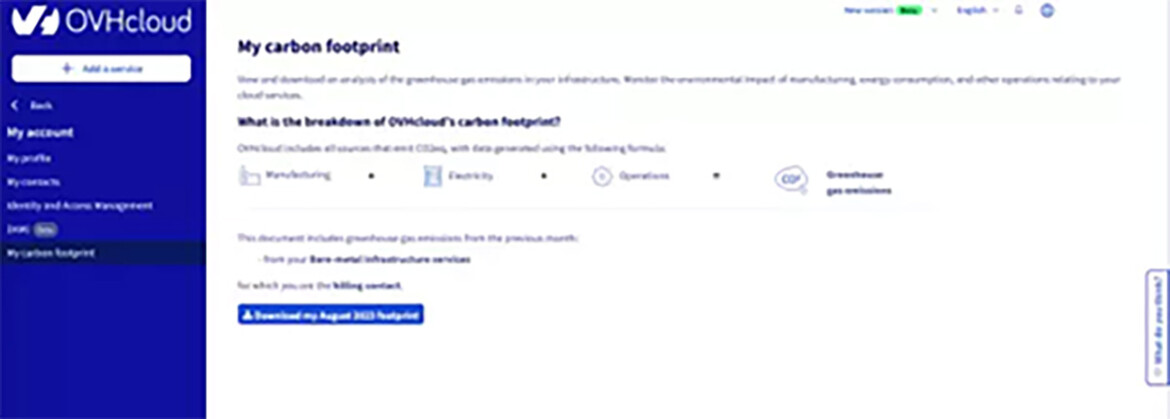How Clean Is Your Data Usage? Measuring Carbon Footprint in the Cloud
The energy consumption of data centers, where cloud services are hosted, contributes significantly to carbon emissions. OVHCloud’s Falk Weinreich shows how companies can measure the sustainability of the IT resources they use.

©Thai Noipho | istockphoto.com
In today's world, sustainability is not just a buzzword; it's a critical factor for businesses to consider if they want to thrive in the long run. As environmental concerns grow and consumer preferences shift towards eco-conscious products and services, IT businesses have to adapt and implement sustainable practices to gain a competitive edge and establish a positive brand reputation.
The topic of energy efficient cloud computing has become a priority for the EU. Data centers need to become more energy efficient, with a view to becoming carbon-neutral by 2030.
One of the most significant ways for IT companies to reduce their environmental impact is to reduce their carbon footprint. Data centers in particular, the backbone of the digital world, consume vast amounts of energy and generate significant carbon emissions. IT providers can significantly lower their carbon footprint through sustainable practices in their data centers, for example by lowering their energy and water consumption, re-using waste heat, and introducing circular economy principles for their servers and other hardware components.
Cloud computing and carbon emissions
“But I’m not operating my own data center” – yet cloud usage still leads to carbon emissions, and cloud usage is at an all-time high, with 9 of 10 businesses in Germany already utilizing cloud applications. Cloud computing, while offering immense benefits in terms of scalability and flexibility, is not exempt from environmental concerns. The energy consumption of data centers, where cloud services are hosted, contributes significantly to carbon emissions. Many businesses, in their pursuit of digital transformation, may not be fully aware of the environmental impact of their cloud infrastructure. Recognizing this, the European cloud provider OVHcloud has taken a proactive approach by providing its customers with a tool to measure and understand their carbon footprint.
Calculating your carbon footprint in the cloud
OVHcloud's Carbon Calculator is designed to offer IaaS (Infrastructure as a Service) customers monthly reports on their cloud-related carbon emissions. Unlike generic calculators, OVHcloud's tool goes beyond estimating carbon emissions solely from energy consumption. The methodology involved in its development spans over eight months and is exhaustive, considering factors from manufacturing down to the component level of the servers.
The calculator is location-based since different locations make use of a different array of energy sources. While some areas offer the option to rely on sustainable energy sources, others may not be able to do this. To enable an accurate calculation, the carbon calculator reflects the carbon intensity of the local power mix. This ensures a more accurate representation of the environmental impact based on the geographical location of the servers. Moreover, the tool takes into account various factors such as electrical consumption, cooling and networking equipment, freight, manufacturing, end-of-life processes, and waste management. This comprehensive approach not only provides businesses with a complete picture of their actual carbon footprint but is also completely free of charge.
Foresight is better than hindsight
Being aware of your emissions and closely monitoring your carbon footprint is essential for any modern business – but is it enough? To fully adapt a sustainable business model and mindset, sustainability has to be part of the full IT strategy right from the beginning. When choosing IT service providers, going for a sustainable supplier should already be a major point to be considered, regardless of it being a provider for cloud or any other IT services.
Concerning the choice of a Cloud provider, metrics such as Water Usage Effectiveness (WUE) and Power Usage Effectiveness (PUE) are vital criteria. PUE and WUE are widely used metrics to evaluate the sustainability of data centers. PUE measures the ratio of total power consumed by a data center to the power consumed by IT equipment, while WUE measures the liters of water used per kilowatt-hour (kWh) of electricity consumed by the data center. Both metrics provide valuable insights into the efficiency of data center operations and can help identify areas for improvement. However, PUE and WUE have limitations in fully reflecting the overall carbon footprint of data centers. They primarily focus on internal data center operations, neglecting the indirect energy consumption associated with electricity generation and water treatment. They also don’t take into consideration the emissions produced during the production of the hardware components and the waste they produce after the end of their life.
Cloud providers such as the European player OVHcloud extend their commitment to sustainability beyond the introduction of a Carbon Calculator. For example, OVHcloud has adopted a vertically integrated industrial model, with most data centers owned and built by the group.

Clients can use the Carbon Calculator to figure out their carbon footprint in the cloud
This model is anchored in OVHcloud’s commitment to keeping full control of the supply chain by producing as much as possible on their own – which even extends to OVHcloud manufacturing their own server components. Furthermore, the use of proprietary innovations and sustainable practices, such as water cooling at scale, enables the company to achieve remarkable scores in water usage effectiveness (WUE) and power usage effectiveness (PUE). The newly launched Carbon Calculator complements these efforts.
Sustainability is everywhere – even in the cloud
Sustainability has long surpassed the status of “nice to have” and has become a “must have”. Not only is it necessary for businesses to stay competitive, but also to keep up with the latest regulations. This makes it imperative for businesses to adapt a holistic and sustainable approach. This also includes considering departments of your business that might not be an obvious area for improving sustainability. By providing customers with transparent and exhaustive carbon footprint information, tools such as the Carbon Calculator empower businesses to make informed decisions with regards to their IT infrastructure. As the digital landscape continues to evolve, advanced measurement and monitoring tools pave the way for a more environmentally conscious approach to technology, ensuring a harmonious balance between technological innovation and ecological responsibility. This approach must span all the way from initial decision-making to measuring the emissions of already existing infrastructure and provided services to considering the potential impact of future investments. To achieve this, choosing sustainable business partners should always be the top priority.
Falk Weinreich is General Manager Central Europe at OVHcloud. He has been leading the business in Germany, Austria and Switzerland since December 2019. His primary mission is to bolster the company’s market presence within the region, while concurrently strengthening the channel business.
Please note: The opinions expressed in Industry Insights published by dotmagazine are the author’s or interview partner’s own and do not necessarily reflect the view of the publisher, eco – Association of the Internet Industry.





